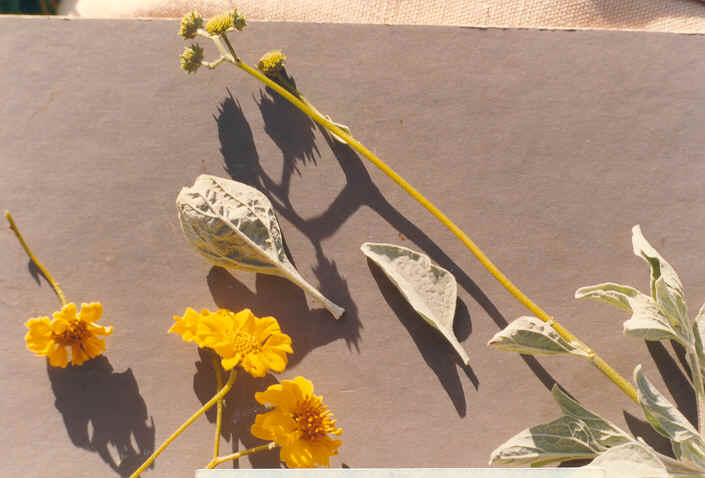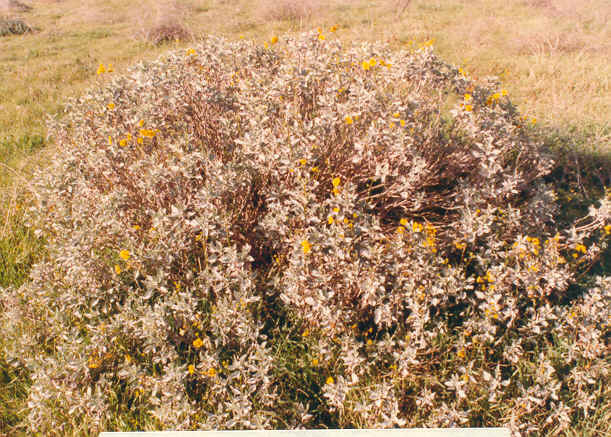
Encelia farinosa Torrey & A. Gray
Asteraceae (Sunflower Family)
Native
Brittle-Bush
Incienso
 |
Encelia farinosa Torrey & A. GrayAsteraceae (Sunflower Family)Native
Brittle-BushIncienso
|
January Photo
Plant Characteristics:
Perennial roundish bush, 3-8 (-16) dm. high, fragrant, from a woody trunk
and bearing dense clusters of lvs. of the season, sap fragrant; lvs. clustered
near stem tips, narrowly to broadly ovate, obtuse to acute, entire or
+/-repand-toothed, silvery-tomentose, 3-8 cm. long, on shorter petioles; heads
radiate, 3-9 in almost naked panicles, with whitish-yellow branches, quite
glabrous except under the heads; invol. 5-8 mm. high; phyllaries lanceolate;
rays 11-21, 10-15 mm. long, neutral; disk-fls. 5-6 mm., yellow brown or purple,
flat, obovate, villous-ciliate; pappus none.
Habitat:
Dry stony slopes below 3000 ft.; Creosote Bush Scrub, Coastal Sage Scrub;
Death V. region s. through e. Mojave Desert to Colo. Desert; w. Riverside and
San Bernardino cos., coastal San Diego Co.; to Utah, L. Calif., Mex.
March-May.
Name:
See E. californica for origin
of the genus name. Latin, farinosus, mealy. (Jaeger
101). Probably referring to the
gray leaves.
General:
Rare in the study area, having been found only once and this on a sloping
hillside westerly of the terminus of the Delhi Ditch into the Upper Bay.
I have watched this plant for several years and while it was a fine
specimen, several feet in diameter and over two feet high, it has now
deteriorated to a partially living skeleton of the original.
I have no ideas as to why this plant is dying other than lack of rainfall
and the fact that it is out of its normal habitat. John Johnson has suggested
that the normal life span of the plant is short.
Other plants were introduced along the horse and bike path, that passes
through Santa Ana Heights, by hydromulching in 1987.
(my comments).
The foliage of Incienso exudes bubbles of resinous gum sometimes used in
the past for incense, chewing gum, varnish and pain killers.
(Dale 61). The
stems exude a fragrant resin that was chewed by the Indians and used as incense
in the churches of Baja California. (Spellenberg
360). Encelia
species have been known to cause dermatitis.
(Fuller 370).
The tea has a strongly bitter and slightly numbing effect.
It is a well known folk remedy in northern Mexico for arthritis that is
aggravated by cold and damp weather, 2-3 oz. of the decoction three times a day
while the pain is acute. Cahuilla
and Mojave Indians used it for a mouthwash and retained gargle for tooth and gum
pain; it worked quite nicely. (Moore,
Medicinal Plants of the Desert and Canyon West 51).
Text Ref:
Abrams, Vol. IV 123; Hickman, Ed. 249; Munz, Flora
So. Calif. 158; Roberts 10.
Photo Ref:
Jan 1 84 # 23,24.
Identity: by R. De Ruff,
confirmed by F. Roberts
Computer Ref: Plant Data 167.
Have plant specimen.
Last edit 10/13/02.
 |
January Photo